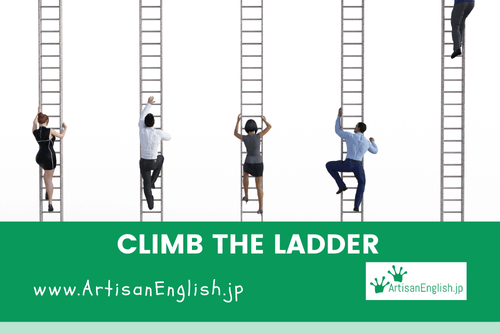
YouTube / iTunes / Spotify / Radio Public / Pocket Casts / Google Podcasts / Breaker / Overcast
Listen to ArtisanEnglish.jp posts & lesson intros here.
Idiom: Climb the ladder
Traditionally, the boomer generation and Generation X were known for their dedication to climbing the ladder, giving their all to reach the top of their chosen career paths.
They lived in a time when loyalty to a company and hard work often paid off with promotions and job security.
The idiom climb the ladder means to advance or achieve higher positions in life, whether in your career or personal growth.
It often symbolizes hard work, ambition, and determination.
For many in these generations, climbing the ladder meant starting at the bottom by doing the heavy lifting and, over time, steadily moving up.
They sacrificed years of their lives to achieve success, often spending long hours at work.
This commitment was deeply embedded in their values.
They believed that climbing the ladder was a sign of achievement and stability.
However, if we look at younger generations like Millennials and Generation Z, we see a shift in perspective.
Many young people today view the traditional climb-the-ladder approach as passé.
Instead of working tirelessly for a single company, they seek work-life balance and prioritize personal fulfillment over climbing the ladder.
They are more inclined to explore different career paths, freelance opportunities, and entrepreneurship, believing that success can come in various forms, not just by climbing the corporate ladder.
So, while the boomer generation and Generation X diligently climbed the ladder to professional success, younger generations are redefining what it means to achieve their goals.
They might not seek to climb the ladder at all, but they are still reaching for success, just on their own terms.
Understanding this shift can help bridge the gap between different generations in the workplace and beyond.
Flesch-Kincaid Readability Test
This post is understandable by someone with at least a 9th-grade education (age 15).
On the Flesch-Kincaid reading-ease test, this post scores 51.
The easier a passage is to read, the higher the score on a scale of 0 – 100.

